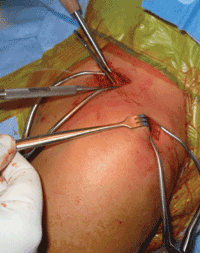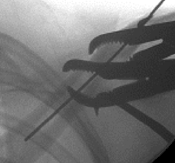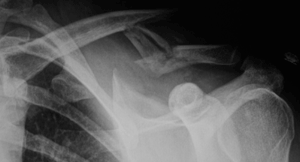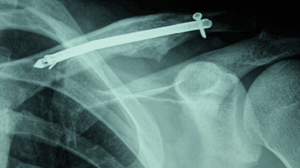Rigid internal fixation of displaced midshaft clavicle fractures
 Stephen B. Gunther |
The treatment of displaced clavicle fractures has historically been mostly nonoperative. However, several recent peer-reviewed clinical outcome studies have demonstrated a significantly higher nonunion rate for displaced fractures treated nonoperatively than previously published. Also, other recent studies have shown improved fixation with modern implants and improved surgical results with plate fixation compared to historical reports.
This article describes new technology for the treatment of displaced midshaft clavicle fractures using a flexible intramedullary (IM) device which becomes rigid when deployed with a torque driver after the fracture is reduced.
Preoperative planning, setup
Preoperative evaluation of patients with displaced midshaft clavicle fractures involves a patient history including any relevant trauma to the chest and other organs, physical examination and discussion of patient activity level and expectations. Standard radiographs include X-rays of the clavicle — AP X-ray of the clavicle and an apical lordotic view with 45° cephalic tilt — and a chest X-ray. Digital radiographs of the clavicle are extremely helpful in measuring the medullary canal diameter.
Patients are intubated and then placed in a modified beach chair position. The C-arm can either be brought in from across the body or from above the shoulder — next to the anesthesia provider. The shoulder must be supported by a radiolucent back or have a pull-out shoulder area so that C-arm images of the clavicle can be obtained easily. Images showing the entire clavicle in orthogonal planes should be performed before surgery begins.
|
Images: Gunther SB |
Repositioning may be necessary at this point if the view is blocked by a headrest or metal in the operating table. It is crucial to prep and drape a wide field about the shoulder, neck, and chest so that the medial clavicle and the notch behind the acromioclavicular joint are both exposed. There must be plenty of room to extend the incisions if necessary.
Incisions
A 3- to 4-cm vertical incision is made in Langer’s lines at the site of the fracture. If necessary, the incision can be extended in an oblique fashion for severely comminuted fractures. The supraclavicular nerves can be dissected and protected with a blunt retractor. The platysma muscle is incised and the fracture fragments are exposed.
Minimal periosteal elevation is performed at the ends of the medial and lateral fragments. The rest of the periosteum should not be disturbed unless there is a difficult reduction that requires further dissection. A second 2-cm incision posterior to the acromioclavicular joint will be performed later in the procedure.
The next step involves preparation of the medial fragment. Sounding of the IM canal can be performed with a K-wire, small drill bit or awl. This is always performed under fluoroscopic visualization to prevent perforating the cortex. The subclavian artery, vein and brachial plexus are located within 1- to 2-cm of the clavicle, as described by Lo and colleagues in Orthopedics in 2010. A guide wire can be utilized along with a 4.5-mm cannulated drill bit after initial preparation is performed under fluoroscopic guidance.
|
|
Exposure
Exposure of the lateral fragment involves external rotation of the shoulder in order to pull the lateral fragment forward. A guide wire is placed in the lateral clavicle fragment and driven through the bone posterior to the acromioclavicular joint at the curve in the distal clavicle. The guide wire is driven through the bone, deltotrapezial muscle and skin.
A 2-cm vertical incision is performed at this site, and the muscle is gently split inline with the fibers to expose the posterior margin of the distal clavicle where the guide wire exits the bone (Figure 1). The guide wire is pulled through the fracture site, and then the fracture is reduced. The guide wire is then driven back down the medial shaft.
Multiple fluoroscopic images are used to confirm anatomic alignment of the fracture and no cortical penetration by the guide wire (Figure 2). The appropriate-size cannulated drill or reamer is then used to drill or ream the canal from lateral to medial. It is important to avoid drilling or reaming past the medial tip of the guide wire because this may cause cortical penetration and possible neurovascular injury.
Assuring rigidity
The guide wire is then replaced by a depth gauge. The final implant with the appropriate length is then inserted. It is important to note that the solid section of the implant should bypass the fracture site by 2 cm in order to maximize strength and rigidity of the fixation.
A torque driver is placed in the lateral end of the implant to expand the medial grippers of the device and lock the flexible device into a rigid position while the fracture site is compressed. A final screw is placed through the lateral end of the implant for rotational control. Final fluoroscopic images are used to confirm adequate alignment of the device and fracture. The device can be removed and realigned if necessary. The skin incisions are closed with a fascial suture layer and then subcuticular skin closure. The patient is placed in a sling and can be discharged home the same day.
Postoperative care
Most patients are treated in a sling for 3 to 4 weeks but begin immediate passive motion and sometimes gentle active motion exercises as directed by the surgeon. The timing of rehabilitation depends on the severity of the trauma and type of fracture pattern. Overhead exercises are avoided until signs of fracture healing are demonstrated, usually between 3 and 6 weeks postoperatively. Radiographic evidence of healing is used as a barometer for return of functional activities.
|
|
Case example
A 30-year-old, 210 lb Australian rugby player fractured his left clavicle when tackling another player. Radiographic images showed a comminuted z-type midshaft clavicle fracture. After a thorough discussion of different treatment options, he decided to proceed with operative repair. He preferred IM fixation because of its advantage in preserving the periosteal blood supply to the bone.
Fracture fixation was performed with a flexible IM device (Sonoma Orthopedic Products, Inc.). He used his sling for 4 weeks and then began active exercises. He returned to work as an electrician with no restrictions 10 weeks postoperatively. Fluoroscopic radiographic images showed complete healing at 3 months and remodeling at 6 months after surgery. He returned to playing rugby 5 months after surgery.
|
|
Discussion
The treatment of displaced midshaft clavicle fractures has changed. While most of these fractures were treated with a sling, figure-of-eight harness or benign neglect previously, recent studies have shown improved results with operative reduction and fixation.
This article demonstrates a technique utilizing a solid implant with an initially flexible tip which becomes rigid after deployment with a torque driver. This is a safe and effective treatment option which minimizes soft tissue disruption and can be performed through cosmetic incisions.
References:
- Altamimi SA, et al, the Canadian Orthopaedic Trauma Society. Nonoperative treatment compared with plate fixation of displaced midshaft clavicular fractures. Surgical technique. J Bone Joint Surg (Am). 2008;90:1-8.
- Canadian Orthopedic Trauma Society. Nonoperative treatment compared with plate fixation of displaced midshaft clavicular fractures. J Bone Joint Surg (Am). 2007;89:1-10.
- Hill JM, et al. Closed treatment of displaced middle-third fractures of the clavicle gives poor results. J Bone Joint Surg (Br). 1997;79(4):537-539.
- McKee MD, et al. Functional outcome following clavicle fractures in polytrauma patients. J Trauma. 1999;47:616.
- Neer CS 2nd. Nonunion of the clavicle. JAMA. 1960; 172(10):1006-1111.
- Nordqvist A, et al. Mid-clavicle fractures in adults: End result study after conservative treatment. J Orthop Trauma. 1998;12(8):572-576.
- Lo EY, at al. Neurovascular risks of anteroinferior clavicular plating. Orthopedics. 2010;33:21.
- Rowe CR. An atlas of anatomy and treatment of midclavicular fractures. Clin Orthop Relat Res.1968;(58):29-42.
- Stephen B. Gunther, MD, and Tennyson L. Lynch can be reached at Frank R. Howard Memorial Hospital, 84 Madrone St., Willits, CA 95490; 707-459-6855; e-mail: sbgunther@aol.com.
- Disclosures: Gunther is a consultant, inventor and medical advisory board member with stock options for Sonoma Orthopaedic Products, Inc. Lynch was previously a paid employee for Sonoma Orthopaedic Products, Inc.




